Intel Xeon E5-2600 v2: More Cores, Cache, And Better Efficiency
Intel recently launched its Xeon E5-2600 v2 CPU, based on the Ivy Bridge-EP architecture. We got a couple of workstation-specific -2687W v2 processors with eight cores and 25 MB of L3 cache each, and are comparing them to previous-generation -2687Ws.
Results: Media Encoding
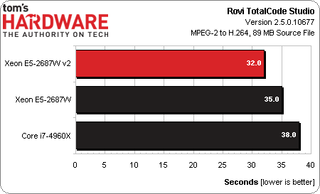
Rovi’s TotalCode Studio certainly doesn’t scale according to core count or cost. However, two Xeon E5-2687W v2 CPUs are quicker than last generation’s Xeon E5-2687Ws, which are in turn faster than a single Core i7-4960X. Because the gains are so small, though, you probably won’t rush to add cores if you’re encoding video with TotalCode.
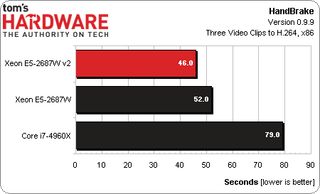
Converting video clips to H.264 in HandBrake scales far better. This is particularly interesting because HandBrake employs the x264 encoder, which is really well-optimized for many-core CPUs. Beyond that, there are builds of HandBrake that support Intel’s Quick Sync technology and OpenCL (which offloads cropping and down-scaling to GPUs).
Also, we know from our early work with x265 (Next-Gen Video Encoding: x265 Tackles HEVC/H.265) that next-gen encoders are going to be very performance-hungry as they facilitate higher quality at the same bit rates or the same quality at lower bit rates compared to H.264. When quality necessitates a software encoder, expect the very fastest host processors to deliver the best experience.
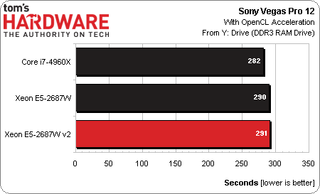
Like Photoshop, Sony Vegas uses OpenCL acceleration to speed up this workload. Our Quadro FX 1800 sits around 82% utilization, while IA cores hover under 25% on the Core i7. And also like Photoshop, performance doesn’t improve on a platform with more cores. Instead, the Core i7 is fastest, while the Xeon setups essentially tie.
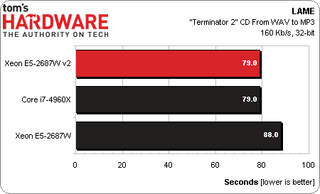
LAME and iTunes, both single-threaded metrics, reflect the same thing: Ivy Bridge at high clock rates is quicker than Sandy Bridge at lower frequencies. Much of this is owed to Intel’s transition from 32 to 22 nm manufacturing, facilitating more aggressive settings within the same thermal envelope.
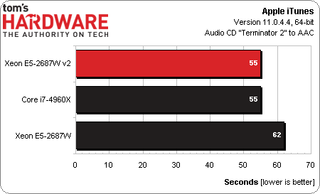
Stay on the Cutting Edge
Join the experts who read Tom's Hardware for the inside track on enthusiast PC tech news — and have for over 25 years. We'll send breaking news and in-depth reviews of CPUs, GPUs, AI, maker hardware and more straight to your inbox.
-
GL1zdA1 Does this mean, that the 12-core variant with 2 memory controllers will be a NUMA CPU, with cores having different latencies when accessing memory depending on which MC is near them?Reply -
Draven35 The Maya playblast test, as far as I can tell, is very single-threaded, just like the other 3d application preview tests I (we) use. This means it favors clock speed over memory bandwidth.Reply
The Maya render test seems to be missing O.o
-
Cryio Thank you Tom's for this Intel Server CPU. I sure hope you'll make a review of AMD's upcoming 16 core Steamroller server CPUReply -
voltagetoe If you've got 3ds max, why don't you use something more serious/advanced like Mental Ray ? The default renderer tech represent distant past like year 1995.Reply -
lockhrt999 "Our playblast animation in Maya 2014 confounds us."@canjelini : Apart from rendering, most of tools in Maya are single threaded(most of the functionality has stayed same for this two decades old software). So benchmarking maya playblast is as identical as itunes encode benchmarking.Reply -
daglesj I love Xeon machines. As they are not mainstream you can usually pick up crazy spec Xeon workstations for next to nothing just a few years after they were going for $3000. They make damn good workhorses.Reply -
InvalidError @GL1zdA1: the ring-bus already means every core has different latency accessing any given memory controller.Memory controller latency is not as much of a problem with massively threaded applications on a multi-threaded CPU since there is still plenty of other work that can be done while a few threads are stalled on IO/data. Games and most mainstream applications have 1-2 performance-critical threads and the remainder of their 30-150 other threads are mostly non-critical automatic threading from libraries, application frameworks and various background or housekeeping stuff.Reply -
mapesdhs Small note, one can of course manually add the Quadro FX 1800 to the relevant fileReply
(raytracer_supported_cards.txt) in the appropriate Adobe folder and it will work just
fine for CUDA, though of course it's not a card anyone who wants decent CUDA
performance with Adobe apps should use (one or more GTX 580 3GB or 780Ti is best).
Also, hate to say it but showing results for using the card with OpenCL but not
showing what happens to the relevant test times when the 1800 is used for CUDA
is a bit odd...
Ian.
PS. I see the messed-up forum posting problems are back again (text all squashed
up, have to edit on the UK site to fix the layout). Really, it's been months now, is
anyone working on it?
Most Popular


